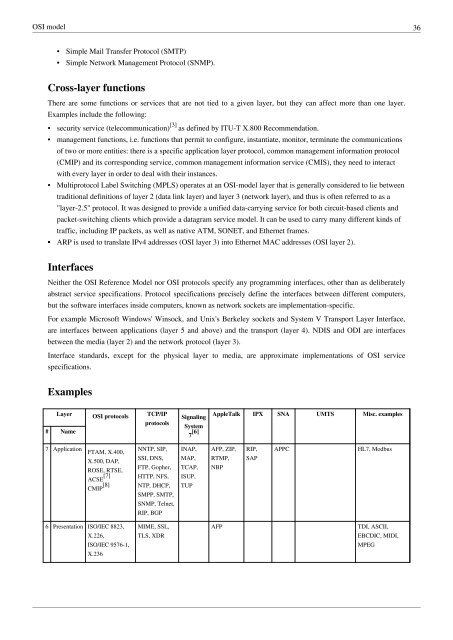Internet Protocol - Research by Kirils Solovjovs
Internet Protocol - Research by Kirils Solovjovs
Internet Protocol - Research by Kirils Solovjovs
Create successful ePaper yourself
Turn your PDF publications into a flip-book with our unique Google optimized e-Paper software.
OSI model 36<br />
• Simple Mail Transfer <strong>Protocol</strong> (SMTP)<br />
• Simple Network Management <strong>Protocol</strong> (SNMP).<br />
Cross-layer functions<br />
There are some functions or services that are not tied to a given layer, but they can affect more than one layer.<br />
Examples include the following:<br />
• security service (telecommunication) [3] as defined <strong>by</strong> ITU-T X.800 Recommendation.<br />
• management functions, i.e. functions that permit to configure, instantiate, monitor, terminate the communications<br />
of two or more entities: there is a specific application layer protocol, common management information protocol<br />
(CMIP) and its corresponding service, common management information service (CMIS), they need to interact<br />
with every layer in order to deal with their instances.<br />
• Multiprotocol Label Switching (MPLS) operates at an OSI-model layer that is generally considered to lie between<br />
traditional definitions of layer 2 (data link layer) and layer 3 (network layer), and thus is often referred to as a<br />
"layer-2.5" protocol. It was designed to provide a unified data-carrying service for both circuit-based clients and<br />
packet-switching clients which provide a datagram service model. It can be used to carry many different kinds of<br />
traffic, including IP packets, as well as native ATM, SONET, and Ethernet frames.<br />
• ARP is used to translate IPv4 addresses (OSI layer 3) into Ethernet MAC addresses (OSI layer 2).<br />
Interfaces<br />
Neither the OSI Reference Model nor OSI protocols specify any programming interfaces, other than as deliberately<br />
abstract service specifications. <strong>Protocol</strong> specifications precisely define the interfaces between different computers,<br />
but the software interfaces inside computers, known as network sockets are implementation-specific.<br />
For example Microsoft Windows' Winsock, and Unix's Berkeley sockets and System V Transport Layer Interface,<br />
are interfaces between applications (layer 5 and above) and the transport (layer 4). NDIS and ODI are interfaces<br />
between the media (layer 2) and the network protocol (layer 3).<br />
Interface standards, except for the physical layer to media, are approximate implementations of OSI service<br />
specifications.<br />
Examples<br />
Layer OSI protocols TCP/IP<br />
# Name<br />
7 Application FTAM, X.400,<br />
X.500, DAP,<br />
ROSE, RTSE,<br />
ACSE [7]<br />
CMIP [8]<br />
6 Presentation ISO/IEC 8823,<br />
X.226,<br />
ISO/IEC 9576-1,<br />
X.236<br />
protocols<br />
NNTP, SIP,<br />
SSI, DNS,<br />
FTP, Gopher,<br />
HTTP, NFS,<br />
NTP, DHCP,<br />
SMPP, SMTP,<br />
SNMP, Telnet,<br />
RIP, BGP<br />
MIME, SSL,<br />
TLS, XDR<br />
Signaling<br />
System<br />
7 [6]<br />
INAP,<br />
MAP,<br />
TCAP,<br />
ISUP,<br />
TUP<br />
AppleTalk IPX SNA UMTS Misc. examples<br />
AFP, ZIP,<br />
RTMP,<br />
NBP<br />
RIP,<br />
SAP<br />
APPC HL7, Modbus<br />
AFP TDI, ASCII,<br />
EBCDIC, MIDI,<br />
MPEG


